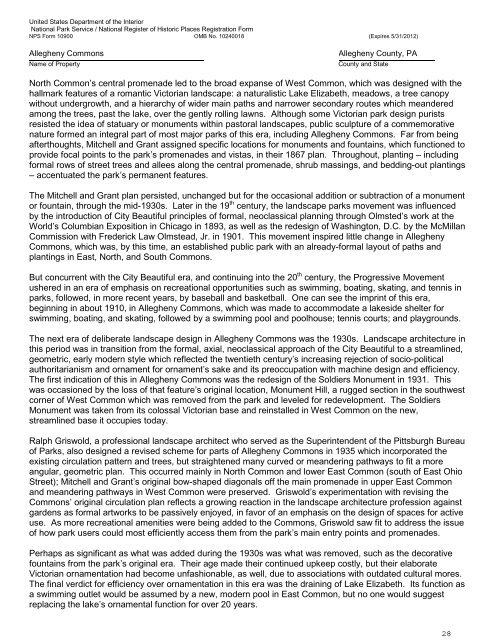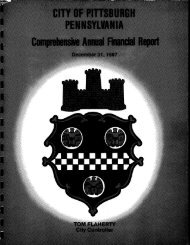Allegheny Commons - City of Pittsburgh
Allegheny Commons - City of Pittsburgh
Allegheny Commons - City of Pittsburgh
Create successful ePaper yourself
Turn your PDF publications into a flip-book with our unique Google optimized e-Paper software.
United States Department <strong>of</strong> the InteriorNational Park Service / National Register <strong>of</strong> Historic Places Registration FormNPS Form 10900 OMB No. 10240018 (Expires 5/31/2012)<strong>Allegheny</strong> <strong>Commons</strong>Name <strong>of</strong> Property<strong>Allegheny</strong> County, PACounty and StateNorth Common’s central promenade led to the broad expanse <strong>of</strong> West Common, which was designed with thehallmark features <strong>of</strong> a romantic Victorian landscape: a naturalistic Lake Elizabeth, meadows, a tree canopywithout undergrowth, and a hierarchy <strong>of</strong> wider main paths and narrower secondary routes which meanderedamong the trees, past the lake, over the gently rolling lawns. Although some Victorian park design puristsresisted the idea <strong>of</strong> statuary or monuments within pastoral landscapes, public sculpture <strong>of</strong> a commemorativenature formed an integral part <strong>of</strong> most major parks <strong>of</strong> this era, including <strong>Allegheny</strong> <strong>Commons</strong>. Far from beingafterthoughts, Mitchell and Grant assigned specific locations for monuments and fountains, which functioned toprovide focal points to the park’s promenades and vistas, in their 1867 plan. Throughout, planting – includingformal rows <strong>of</strong> street trees and allees along the central promenade, shrub massings, and bedding-out plantings– accentuated the park’s permanent features.The Mitchell and Grant plan persisted, unchanged but for the occasional addition or subtraction <strong>of</strong> a monumentor fountain, through the mid-1930s. Later in the 19 th century, the landscape parks movement was influencedby the introduction <strong>of</strong> <strong>City</strong> Beautiful principles <strong>of</strong> formal, neoclassical planning through Olmsted’s work at theWorld’s Columbian Exposition in Chicago in 1893, as well as the redesign <strong>of</strong> Washington, D.C. by the McMillanCommission with Frederick Law Olmstead, Jr. in 1901. This movement inspired little change in <strong>Allegheny</strong><strong>Commons</strong>, which was, by this time, an established public park with an already-formal layout <strong>of</strong> paths andplantings in East, North, and South <strong>Commons</strong>.But concurrent with the <strong>City</strong> Beautiful era, and continuing into the 20 th century, the Progressive Movementushered in an era <strong>of</strong> emphasis on recreational opportunities such as swimming, boating, skating, and tennis inparks, followed, in more recent years, by baseball and basketball. One can see the imprint <strong>of</strong> this era,beginning in about 1910, in <strong>Allegheny</strong> <strong>Commons</strong>, which was made to accommodate a lakeside shelter forswimming, boating, and skating, followed by a swimming pool and poolhouse; tennis courts; and playgrounds.The next era <strong>of</strong> deliberate landscape design in <strong>Allegheny</strong> <strong>Commons</strong> was the 1930s. Landscape architecture inthis period was in transition from the formal, axial, neoclassical approach <strong>of</strong> the <strong>City</strong> Beautiful to a streamlined,geometric, early modern style which reflected the twentieth century’s increasing rejection <strong>of</strong> socio-politicalauthoritarianism and ornament for ornament’s sake and its preoccupation with machine design and efficiency.The first indication <strong>of</strong> this in <strong>Allegheny</strong> <strong>Commons</strong> was the redesign <strong>of</strong> the Soldiers Monument in 1931. Thiswas occasioned by the loss <strong>of</strong> that feature’s original location, Monument Hill, a rugged section in the southwestcorner <strong>of</strong> West Common which was removed from the park and leveled for redevelopment. The SoldiersMonument was taken from its colossal Victorian base and reinstalled in West Common on the new,streamlined base it occupies today.Ralph Griswold, a pr<strong>of</strong>essional landscape architect who served as the Superintendent <strong>of</strong> the <strong>Pittsburgh</strong> Bureau<strong>of</strong> Parks, also designed a revised scheme for parts <strong>of</strong> <strong>Allegheny</strong> <strong>Commons</strong> in 1935 which incorporated theexisting circulation pattern and trees, but straightened many curved or meandering pathways to fit a moreangular, geometric plan. This occurred mainly in North Common and lower East Common (south <strong>of</strong> East OhioStreet); Mitchell and Grant’s original bow-shaped diagonals <strong>of</strong>f the main promenade in upper East Commonand meandering pathways in West Common were preserved. Griswold’s experimentation with revising the<strong>Commons</strong>’ original circulation plan reflects a growing reaction in the landscape architecture pr<strong>of</strong>ession againstgardens as formal artworks to be passively enjoyed, in favor <strong>of</strong> an emphasis on the design <strong>of</strong> spaces for activeuse. As more recreational amenities were being added to the <strong>Commons</strong>, Griswold saw fit to address the issue<strong>of</strong> how park users could most efficiently access them from the park’s main entry points and promenades.Perhaps as significant as what was added during the 1930s was what was removed, such as the decorativefountains from the park’s original era. Their age made their continued upkeep costly, but their elaborateVictorian ornamentation had become unfashionable, as well, due to associations with outdated cultural mores.The final verdict for efficiency over ornamentation in this era was the draining <strong>of</strong> Lake Elizabeth. Its function asa swimming outlet would be assumed by a new, modern pool in East Common, but no one would suggestreplacing the lake’s ornamental function for over 20 years.28
















